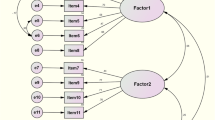Abstract
Purpose The aim of this study was to evaluate the measurement structure of the Employers’ Stigmatizing Attitudes Toward Cancer Survivors Scale (ESATPD-Cancer Scale). Methods A quantitative descriptive design using exploratory factor analysis (EFA) and confirmatory factor analysis (CFA). One hundred and seventy-seven Taiwanese human resources (HR) professionals participated in this study. Results EFA revealed a one-factor measurement structure accounting for 50% of the total variance. We conducted a CFA to confirm the one-factor structure; after two pairs of error terms were correlated, the re-specified model was found to fit the data adequately: χ2/df = 1.69, GFI = 0.97, CFI = 0.98, and RMSEA = 0.06. Internal consistency reliability coefficient (Cronbach’s alpha) for the ESATPD-Cancer Scale was computed to be 0.80. In addition, stigmatizing attitudes were found to be negatively associated with HR professionals’ willingness to hire cancer survivors. Conclusions The results of this study support a one-factor measurement structure for the ESATPD-Cancer Scale in a sample of HR professionals in Taiwan. Findings also support a relationship between ESATPD-Cancer Scale scores and HR professionals’ willingness to hire cancer survivors, demonstrating support for the construct validity of the scale.

Similar content being viewed by others
References
Sung C, Brooks J, Muller V, et al. Chapter 4, Employment and career development. In: Chan F, Bishop M, Chronister J, Lee EJ, Chiu CY, editors. CRC examination preparation: a concise guide to the foundations of rehabilitation counseling. New York: Springer; 2012. p. 57–80
People with Disabilities Rights Protection Act. Taipei: Ministry of Health and Welfare, Laws and Regulations Database of the Republic of China. 2007. http://law.moj.gov.tw/Eng/LawClass/LawAll.aspx?PCode=D0050046. Accessed 28 Mar 2016.
Taiwan Ministry of Labor. Employment rate in Taiwan. Taipei: Taiwan Ministry of Labor; 2014. http://statdb.mol.gov.tw/html/svy03/0342analyze.pdf. Accessed 28 Mar 2016.
Burke J, Bezyak J, Fraser RT, et al. Employers’ attitudes towards hiring and retaining people with disabilities: a review of the literature. Aust J Rehabil Couns. 2013;19(1):21–38. https://doi.org/10.1017/jrc.2013.2.
Strauser D, Feuerstein M, Chan F, et al. Vocational services associated with competitive employment in 18–25 year old cancer survivors. J Cancer Surviv. 2010;4(2):179–186. https://doi.org/10.1007/s11764-010-0119-9.
Amir Z, Wynn P, Chan F, et al. Return to work after cancer in the UK: attitudes and experiences of line managers. J Occup Rehabil. 2010;20(4):435–442. https://doi.org/10.1007/s10926-009-9197-9.
Chan F, Cardoso L, Copeland J, et al. Workplace accommodations. In: Feuerstein M, editor. Work and cancer survivors. New York: Springer; 2009. p. 233–254.
De Boer AG, Taskila T, Ojajärvi A, et al. Cancer survivors and unemployment: a meta-analysis and meta-regression. JAMA 2009;301(7):753–762. https://doi.org/10.1001/jama.2009.187.
Feuerstein M. Work and cancer survivors. New York: Springer; 2009.
Mehnert A. Employment and work-related issues in cancer survivors. Crit Rev Oncol Hematol. 2009; 77(2):109–130. https://doi.org/10.1016/j.critrevonc.2010.01.004.
Chan F, Strauser D, Cardoso E, et al. State vocational services and employment in cancer survivors. J Cancer Surviv. 2008;2(3):169–178. https://doi.org/10.1007/s11764-008-0057-y.
Amir Z, Strauser DR, Chan F. Chapter 3, Employers’ and survivors’ perspectives. In: Feuerstein M, editor. Work and cancer survivors. New York: Springer; 2009. p. 73–89.
Chan F, Strauser D, Maher P, et al. Demand-side factors related to employment of people with disabilities: a survey of employers in the midwest region of the United States. J Occup Rehabil. 2010;20(4):412–419. https://doi.org/10.1007/s10926-010-9252-6.
Fraser R, Ajzen I, Johnson K, et al. Understanding employers’ hiring intention in relation to qualified workers with disabilities. J Vocat Rehabil. 2011;35(1):1–11. https://doi.org/10.3233/JVR-2011-0548.
Chan F, Strauser D, Gervey R, et al. Introduction to demand-side factors related to employment of people with disabilities. J Occup Rehabil. 2010;20(4):407–411. https://doi.org/10.1007/s10926-010-9243-7.
Strauser D, Chan F. Demand side employment factors affecting job placement and job retention among people with disabilities. Paper presented at Cancer Survivorship and Work Seminar; 2007; Goldsmith College, London.
Chiu CY, Chan F, Strauser D, et al. State rehabilitation services tailored to employment status among cancer survivors. J Occup Rehabil. 2014;24(1):89–99. https://doi.org/10.1007/s10926-013-9434-0.
Brislin RW. Back-translation for cross-cultural research. J Cross Cult Psychol. 1970;1(3):185–216. https://doi.org/10.1177/135910457000100301.
Maneesriwongul W, Dixon JK. Instrument translation process: a methods review. J Adv Nurs. 2004;48(2):175–186. https://doi.org/10.1111/j.1365-2648.2004.03185.x.
Weston R, Gore PA Jr, Chan F, et al. An introduction to using structural equation models in rehabilitation psychology. Rehabil Psychol. 2008;53(3):340–356. https://doi.org/10.1037/a0013039.
Byrne B. Structural equation modeling with AMOS: basic concepts, applications and programming. 2nd ed. New Jersey: Lawrence Erbaum Associates; 2001.
Kaiser HF. The varimax criterion for analytic rotation in factor analysis. Psychometrika. 1958;23(3):187–200.
Cattell JL. The scree test for the number of factors. Multivar Behav Res. 1966;1(2):245–276. https://doi.org/10.1207/s15327906mbr0102_10.
Van Prooijen JW, Van Der Kloot WA. Confirmatory analysis of exploratively obtained factor structures. Educ Psychol Meas. 2001;61(5):777–792. https://doi.org/10.1177/00131640121971518.
Schwartz G. Estimating the dimension of a model. Ann Stat. 1978;6(2):461–464.
Comrey AL, Lee HB. Interpretation and application of factor analytic results. In: Comrey AL, Lee HB, editors. A first course in factor analysis. 2nd ed. New York: Psychology Press; 1992. p. 240–259
Funding
This study was funded by the U.S. Department of Health and Human Services (Grant Number: H133B100034).
Author information
Authors and Affiliations
Corresponding author
Ethics declarations
Conflict of interest
The authors declare that they have no conflict of interest.
Ethical Approval
All procedures followed were in accordance with the ethical standards of the responsible committee on human experimentation (Institutional and national) and with the Helsinki Declaration of 1975, as revised in 2000.
Informed Consent
Informed consent was obtained from all individual participants included in the study.
Rights and permissions
About this article
Cite this article
Tu, WM., Pfaller, J., Iwanaga, K. et al. A Psychometric Validation of the Employers’ Stigmatizing Attitudes Toward Cancer Survivors Scale . J Occup Rehabil 28, 541–547 (2018). https://doi.org/10.1007/s10926-017-9746-6
Published:
Issue Date:
DOI: https://doi.org/10.1007/s10926-017-9746-6




